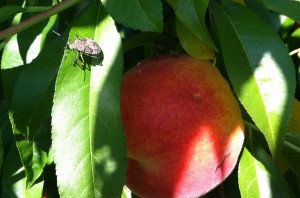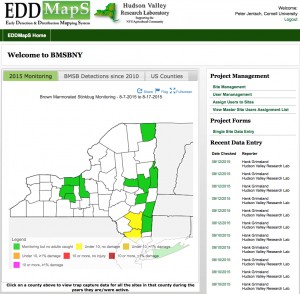
Over the past two weeks we have been seeing a dramatic increase of late instar BMSB nymph movement to pheromone baited Tedders traps in our NY monitored sites, predominately throughout the mid-Hudson Valley. In peach orchards, look for nymph and migrating adults in the cooler parts of the day, early morning and at dusk. Examine fruit for feeding injury as it may not appear obvious during the days shortly after feeding. Over time, the feeding sites will discolor with white corking present beneath the skin.

To date we have not seen traps with threshold adult presence. You can view the EDDMaps/BMSB site to obtain trap threshold updates by NYS county throughout the season.
Applications for management of BMSB should be made at the first available window using one of the most effective insecticides that will best fit your harvest schedule.

The list of the most effective insecticides for BMSB management is found above. NYS labeled insecticides effective for use against the BMSB are available in four major classes including pre-mix formulations. Danitol is likely to be the best choice during the latter part of the season as its short pre-harvest interval and efficacy is a good fit. It is not as effective as Bifenthrin, however, it’s a very good choice for management of BMSB in peach as it has a 3-day PHI, strong efficacy, especially as a knock down insecticide, and also works well against the native stink bugs.
New York’s Section 18 application for the use of products containing bifenthrin has recently been approved by the EPA to control brown marmorated stink bug (BMSB). This is a renewal by the EPA and NYS DEC of a ‘Section 18 Emergency/Crisis Exemption Approval’ use permit for the pyrethroid bifenthrin to control brown marmorated stink bug on apples, peaches, and nectarines this year. Comparative efficacy studies in the lab and field have shown bifenthrin to be one of the most effective insecticides available against BMSB for use in NY State. Although this is an important tool for management of BMSB, the residual against this pest is relatively short lived, requiring vigilance in trapping and scouting 4 days post application.
The regional application request was submitted to EPA from the mid-Atlantic states of DE, MD, NC, NJ, PA,VA, WV and NY state. Its use is limited to Columbia, Dutchess, Orange and Ulster Counties of NY.
Bifenthrin is a pyrethroid sold under the trade names of Brigade WSB (10% bifenthrin, EPA Reg. No. 279-3108, FMC Corp.), Bifenture EC (25% bifenthrin, EPA Reg. No. 70506-227), and Bifenture 10DF (10% bifenthrin, EPA Reg. No. 70506-227, United Phosphorus Inc.).
Labels specific for the Section 18 Exemption for bifenthrin use in NY can be found here:
Brigade WSB
Bifenture EC
Bifenture 10DF
Regardless of the product used, a maximum of 0.08 to 0.2 lb[AI]/acre/season will be allowed, with no more than 0.5 lb a.i./acre applied per year with multiple applications made at a minimum of 30 day intervals; a restricted entry interval (REI) of 12 hours and pre-harvest interval (PHI) of 14 days must be observed. When applying either of these materials for BMSB control on apples, peaches, or nectarines, growers must have possession of the Section 18 label.


